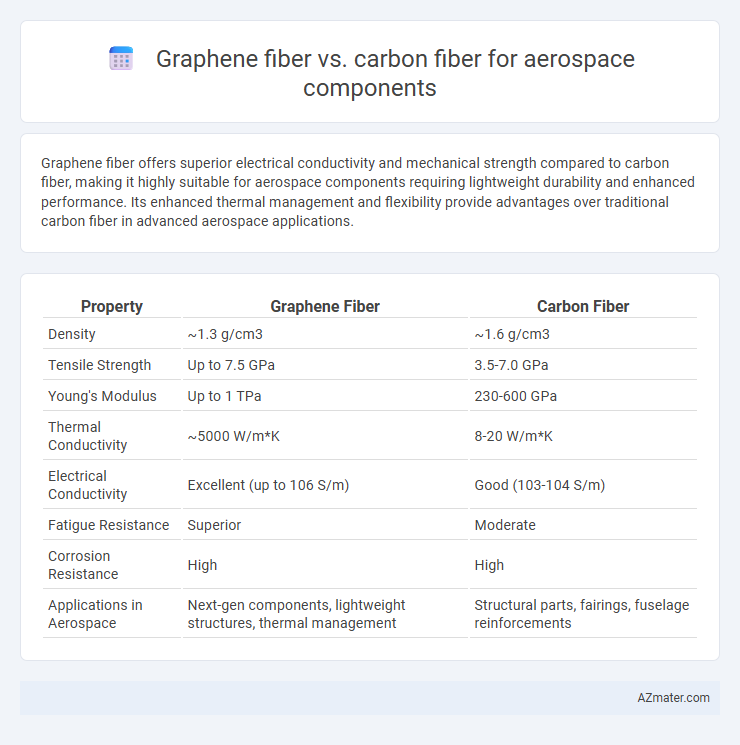Graphene fiber offers superior electrical conductivity and mechanical strength compared to carbon fiber, making it highly suitable for aerospace components requiring lightweight durability and enhanced performance. Its enhanced thermal management and flexibility provide advantages over traditional carbon fiber in advanced aerospace applications.
Table of Comparison
| Property | Graphene Fiber | Carbon Fiber |
|---|---|---|
| Density | ~1.3 g/cm3 | ~1.6 g/cm3 |
| Tensile Strength | Up to 7.5 GPa | 3.5-7.0 GPa |
| Young's Modulus | Up to 1 TPa | 230-600 GPa |
| Thermal Conductivity | ~5000 W/m*K | 8-20 W/m*K |
| Electrical Conductivity | Excellent (up to 106 S/m) | Good (103-104 S/m) |
| Fatigue Resistance | Superior | Moderate |
| Corrosion Resistance | High | High |
| Applications in Aerospace | Next-gen components, lightweight structures, thermal management | Structural parts, fairings, fuselage reinforcements |
Introduction to Advanced Fibers in Aerospace
Graphene fiber and carbon fiber represent cutting-edge materials revolutionizing aerospace components with their exceptional strength-to-weight ratios and durability. Graphene fibers exhibit superior electrical conductivity and flexibility compared to traditional carbon fibers, enabling enhanced performance in critical aerospace applications. The integration of graphene fibers into aerospace structures promises significant advancements in weight reduction, fuel efficiency, and overall structural integrity.
Overview of Graphene Fiber Technology
Graphene fiber technology leverages the exceptional strength, flexibility, and electrical conductivity of graphene, offering significant potential for aerospace components by enhancing performance while reducing weight. Unlike traditional carbon fiber, graphene fibers exhibit superior tensile strength and thermal stability, making them highly suitable for high-stress environments encountered in aerospace applications. The integration of graphene fibers can improve fuel efficiency and structural durability, positioning them as a transformative material in advanced aerospace engineering.
Carbon Fiber: Established Aerospace Standard
Carbon fiber remains the established aerospace standard due to its high strength-to-weight ratio, exceptional stiffness, and proven performance in extreme environments. Its widespread adoption in aircraft structures, including fuselage, wings, and interior components, underscores its reliability and well-documented fatigue resistance. Despite emerging materials like graphene fiber showing promise in conductivity and flexibility, carbon fiber's extensive manufacturing infrastructure and certification history ensure its continued dominance in aerospace applications.
Mechanical Strength: Graphene Fiber vs Carbon Fiber
Graphene fiber exhibits superior tensile strength and elasticity compared to traditional carbon fiber, making it highly advantageous for aerospace components requiring enhanced durability and weight reduction. While carbon fiber typically offers tensile strengths around 3.5 GPa, graphene fiber can exceed 10 GPa, significantly improving mechanical performance under extreme conditions. The exceptional mechanical strength and flexibility of graphene fiber contribute to increased fatigue resistance and impact tolerance, critical for aerospace structural applications.
Weight Efficiency and Density Comparison
Graphene fiber offers exceptional strength-to-weight ratio, with a density around 1.3-1.5 g/cm3, significantly lower than carbon fiber's 1.6-1.8 g/cm3, enabling lighter aerospace components without compromising structural integrity. The superior tensile strength and flexibility of graphene fibers contribute to enhanced weight efficiency, reducing overall aircraft mass and improving fuel efficiency. In aerospace applications, graphene fiber's low density and high mechanical performance provide a competitive advantage in developing next-generation lightweight, high-strength components.
Thermal and Electrical Conductivity in Aerospace Applications
Graphene fiber exhibits superior thermal conductivity, reaching up to 5300 W/mK, significantly outperforming carbon fiber's typical range of 8-15 W/mK, which enhances heat dissipation in aerospace components. Additionally, graphene fiber offers exceptional electrical conductivity, around 10^6 S/m, compared to carbon fiber's lower conductivity, improving electromagnetic interference shielding and sensor integration in aerospace systems. These properties make graphene fiber a promising material for lightweight, thermally efficient, and electrically conductive aerospace applications, optimizing performance and safety.
Durability, Flexibility, and Fatigue Resistance
Graphene fiber exhibits superior durability with enhanced tensile strength and improved resistance to micro-cracking compared to traditional carbon fiber, making it highly suitable for aerospace components exposed to extreme conditions. Its exceptional flexibility allows for better energy absorption and deformation without permanent damage, offering advantages in dynamic stress environments. Graphene's unparalleled fatigue resistance extends the service life of aerospace parts by reducing the onset of material fatigue and structural failure under cyclic loads.
Manufacturing Processes and Scalability
Graphene fiber manufacturing utilizes chemical vapor deposition and wet spinning techniques that allow for fine-tuned control over fiber alignment and strength, offering potential for lightweight, high-tensile aerospace components. Carbon fiber production involves precursor-based stabilization, carbonization, and surface treatment, processes well-established for mass production and consistent mechanical properties across large batches. Scalability favors carbon fiber due to mature industrial infrastructure, while graphene fiber faces challenges in achieving uniform quality and volume, limiting its current aerospace application despite superior theoretical performance.
Cost Analysis and Economic Considerations
Graphene fiber offers superior strength-to-weight ratio compared to carbon fiber but comes at a significantly higher production cost due to complex synthesis and limited scalability. Carbon fiber remains more economically viable for aerospace components with well-established manufacturing processes and lower raw material expenses. The choice between graphene and carbon fibers hinges on balancing upfront investment against long-term performance benefits in aerospace design.
Future Prospects: Graphene and Carbon Fiber in Aerospace
Graphene fiber exhibits exceptional tensile strength, electrical conductivity, and flexibility, positioning it as a promising material for next-generation aerospace components that demand lightweight and high-performance solutions. Carbon fiber currently dominates aerospace applications due to its proven mechanical properties and cost-effectiveness, but graphene's potential to enhance composite materials with improved durability and multifunctional capabilities suggests a transformative impact on future aerospace design. Advancements in scalable graphene fiber production and integration techniques will be critical to surpassing carbon fiber's established role and unlocking new possibilities in aircraft structural efficiency and smart systems.

Infographic: Graphene fiber vs Carbon fiber for Aerospace component
 azmater.com
azmater.com